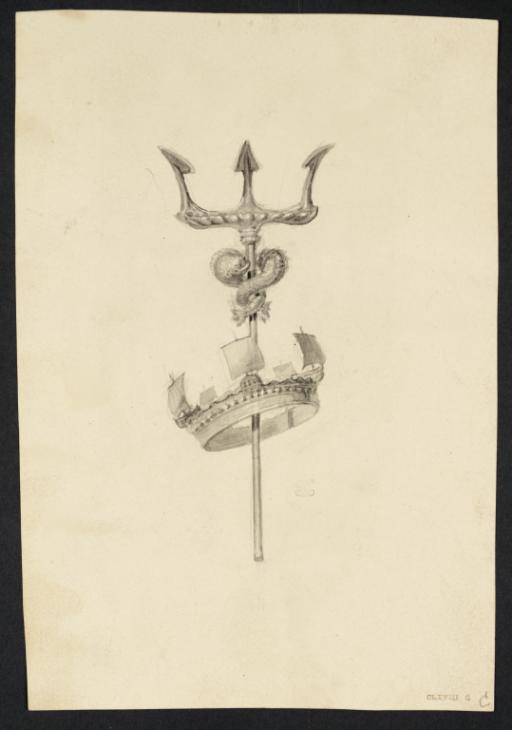Joseph Mallord William Turner Neptune's Trident c.1822-4
Joseph Mallord William Turner,
Neptune's Trident
c.1822-4
Joseph Mallord William Turner 1775–1851
Neptune’s Trident c.1822–4
D13750
Turner Bequest CLXVIII C
Turner Bequest CLXVIII C
Pencil and watercolour on white wove paper, 192 x 133 mm
Blind-stamped with Turner Bequest monogram below right of centre
Inscribed in pencil ‘C’ bottom right
Stamped in black ‘CLXVIII C’ bottom right
Blind-stamped with Turner Bequest monogram below right of centre
Inscribed in pencil ‘C’ bottom right
Stamped in black ‘CLXVIII C’ bottom right
Accepted by the nation as part of the Turner Bequest 1856
References
1862
Walter Thornbury, The Life of J.M.W. Turner, R.A. Founded on Letters and Papers Furnished by his Friends and Fellow-Academicians, London 1862, vol.I, p.402.
1897
Walter Thornbury, The Life of J.M.W. Turner, R.A. Founded on Letters and Papers Furnished by his Friends and Fellow-Academicians: A New Edition, Revised with 8 Coloured Illustrations after Turner’s Originals and 2 Woodcuts, London 1897, p.185.
1913
W[illiam] G[eorge] Rawlinson, The Engraved Work of J.M.W. Turner, R.A., vol.II, London 1913, p.371 under no.770.
1818
A.J. Finberg, A Complete Inventory of the Drawings of the Turner Bequest, London 1909, vol.I, p.488, CLXVIII, as ‘Neptune’s Trident: Vignette on Wrapper of “Marine Views,” 1824–1825. A Trident, with Dolphins Entwined, also a Crown Set with Ships’, c.1818–26.
1979
Andrew Wilton, J.M.W. Turner: His Life and Work, Fribourg 1979, p.357.
1980
John Gage, Collected Correspondence of J.M.W. Turner with an Early Diary and a Memoir by George Jones, Oxford 1980, p.106 letter no.121 and note 1.
1981
Eric Shanes, Turner’s Rivers, Harbours and Coasts, London 1981, pp.33, 153, fig.7.
1990
Luke Herrmann, Turner Prints: The Engraved Work of J.M.W. Turner, Oxford 1990, p.159.
1990
Eric Shanes, Turner’s England 1810–38, London 1990, p.12, ill.4, as ‘Neptune’s Trident’.
1991
Ian Warrell, Turner: The Fourth Decade: Watercolours 1820–1830, exhibition catalogue, Tate Gallery, London 1991, p.29 under no.7.
1993
Jan Piggott, Turner’s Vignettes, exhibition catalogue, Tate Gallery, London 1993, p.12.
1997
Anthony Bailey, Standing in the Sun: A Life of J.M.W. Turner, London 1997, pp.132–3.
This carefully drawn and tinted design, appropriately combining a trident (attribute of Neptune, god of the seas) with dolphins and a fanciful crown with sailing ship motifs, was engraved in line, probably by W.B. Cooke himself, for use on the protective wrappers for the main engraved subjects in Cooke’s short-lived Marine Views series (see the Introduction to this section).
Turner was working on the main watercolours intended for the series between 1822 and 1824. In his survey of Turner’s prints, W.G. Rawlinson dated the engraving to 1825, although it bears no lettering.1 There are no Tate impressions, but the British Museum, London, holds an example.2 The sequence and dating is slightly unclear; Eric Shanes states that the first of the two issued prints, The Edystone Light House, published according to its lettering on 1 March 1824 (Tate impression: T04820) was the one ‘accompanied’ by the vignette, ‘intended to act as a frontispiece for both the parts and the later, bound copies of the whole set of prints’.3 The second and last of the engravings, Sun-rise. Whiting Fishing at Margate, is lettered ‘June 1st 1825’ (Tate impression: T06655).
The original drawing was among numerous largely financial causes of Cooke and Turner falling out and ending their long-standing working and business relationship.4 The relevant passage from a long, despairing letter of self-justification from the ‘thoroughly wound up’ Cooke5 to Turner, dated 1 January 1827, reads:
What possible motive could I have in heaping gold into your pockets when you have always taken such care of your own interests, even in the case of “Neptune’s Trident,” which I can declare you presented to me; and in the spirit of this understanding, I presented it again to Mrs. Cooke. You may recollect afterwards charging me two guineas for the loan of it, and requesting me, at the same time, to return it to you; which has been done.6
Turner’s early biographer Walter Thornbury presumed ‘Cooke must have mistaken a loan for a gift, for Turner never could have been intentionally guilty of such meanness’,7 although Rawlinson was less forgiving.8 Given that Cooke had apparently been paying the very generous rate of sixty guineas per Marine Views watercolour,9 it perhaps seems excessive to fall out so fiercely over this small subsidiary design, but as Shanes puts it in discussing the incident’ Turner ‘was, after all, a professional painter’.10
W[illiam] G[eorge] Rawlinson, The Engraved Work of J.M.W. Turner, R.A., vol.II, London 1913, p.371 no.770.
Jan Piggott, Turner’s Vignettes, exhibition catalogue, Tate Gallery, London 1993, p.12, as 1825, reproduced.
See Gillian Forrester, ‘Cook, William Bernard’ in Evelyn Joll, Martin Butlin and Luke Herrmann (eds.), The Oxford Companion to J.M.W. Turner, Oxford 2001, p.63.
Transcribed in Thornbury 1862, I, p.402; see also Gage 1980, p.106, Shanes 1981, p.153, and Bailey 1997, p.133.
Verso:
Blank; some slight brown staining. Inscribed in pencil ‘UNM. BOX 97’ bottom right.
Matthew Imms
July 2016
How to cite
Matthew Imms, ‘Neptune’s Trident c.1822–4 by Joseph Mallord William Turner’, catalogue entry, July 2016, in David Blayney Brown (ed.), J.M.W. Turner: Sketchbooks, Drawings and Watercolours, Tate Research Publication, February 2017, https://www

